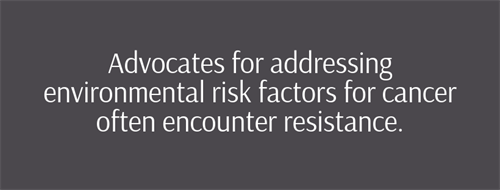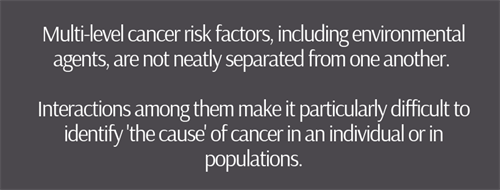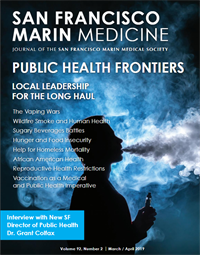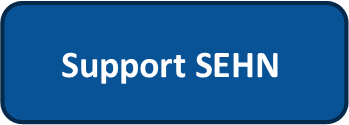|

|

Volume 24 (4) April 2019
|
"While these risk factors point to well-established opportunities to lower risk, they do not fully explain the incidence and trends of many kinds of cancer. Unfortunately, aside from tobacco and alcohol, most cancer prevention programs ignore exposures to cancer-causing chemicals and pollutants in consumer products, homes, workplaces, and the general environment."
-Ted Schettler
|
|
|
|
Friends of SEHN,
Like most people, given a thought-association exercise with the word “cancer”, I would respond with an overwhelming desire to understand how I can prevent it both in myself and my loved ones. I would be looking to specifically protect us from the kinds of cancer that run deeply through the family trees, to prevent more suffering. But it isn’t as simple as a quick trip to the Internet for tips and tricks on beating cancer… What I have learned is that the measures you can take as an individual only go so far in terms of maintaining health and wellness. You can eat all the right things, exercise the recommended amount per day, never smoke, never drink, and so on, but there’s no real way to definitively protect yourself from exposures to carcinogens in an increasingly toxic world. What we are seeing now is less individual power to prevent disease and more people suffering from compounding exposures to multiple risk factors outside of their control—in food, air, and water, the buildings we inhabit, and the general surrounding environment.
While there are certainly steps we can all take to prevent disease, the environmental risk factors we all encounter also need to be factored into the equation. Because we were feverishly cavalier in our pursuit of economic advancement, we are paying for it with our lives, the lives of our beloveds, and the lives of future generations. While that economic advancement also brought with it longer life spans, it also brought more hazardous chemicals and pollutants into our lives.
The Precautionary Principle, a major tenet of SEHN, instructs us to “look before we leap”, and act on early warnings in order to prevent the preventable harm. New technologies have brought us thousands of chemicals to shorten times between seeding and eating, to control pests, to win wars, to reduce costs and increase efficiency—but not without costs, often to our health and environment, many of which are ignored.
We not only need to rectify the decisions we made to use highly toxic pesticides in food production, endangering entire communities by allowing lead in the water supply, and pushing plastic into every crevice of the natural world; we also need to look at systems that are already in place to educate and advise us. As Ted Schettler, SEHN Science Director, will discuss below—major organizations such as the American Cancer Society, still focus primarily on educating people on individual preventive measures such as diet and exercise. In a world that is increasingly toxic with exposures so pervasive, it is imperative that the major health organizations and systems accurately reflect additional environmental risks. What will serve us in the long-term is building upon pre-existing systems to address environmental risk factors. In order to prevent harm (i.e. cancer), we need to prevent human exposure to environmental risk-factors, which means confronting and addressing the toxicity of our world today.
The things we do every day should not be making us sick. Existing in the world today, one with all of the benefits of medical advancement, shouldn’t be making us sick, but it is and increasingly so. We don’t have all of the answers, but scientists, environmentalists, public health experts, and medical professionals are still hard at work to confront the realities of our contaminated, toxic world and programs and policies to address them. Below, Ted Schettler guides us through a recent symposium he attended on cancer and the environment and some of this ongoing work.
Kayhla Cornell
SEHN Senior Communications & Research Associate
|
|
Worldwide more than 17 million people were diagnosed with cancer in 2018 and nearly 10 million died from it. Policies and programs addressing smoking, insufficient physical activity, alcohol, diet, overweight and obesity, and certain infections could prevent a significant proportion of cases, and these have been the primary focus of prevention efforts, usually as advice to individuals urging them to change their behavior. While these risk factors point to well-established opportunities to lower risk, they do not fully explain the incidence and trends of many kinds of cancer. Unfortunately, aside from tobacco and alcohol, most cancer prevention programs ignore exposures to cancer-causing chemicals and pollutants in consumer products, homes, workplaces, and the general environment.
 |
Advocates for addressing environmental risk factors for cancer often encounter resistance. The reasons vary but are most often traced to analyses, beginning more than 35 years ago, estimating that only a few percent of cancers are attributable to occupational or environmental exposures. The original 1981 analysis by Doll and Peto was limited to cancer mortality in people between ages 35-65 yrs., did not address cancer incidence and excluded African-Americans. Although the authors recognized data gaps, the limits of their estimates, the many assumptions underlying them, and that advances in understanding cancer biology might change them substantially, the idea that cancer risk and prevention are overwhelmingly dependent on individual behavioral choices was firmly established.
Today, many mainstream cancer organizations, including the American Cancer Society, follow that tradition. They conclude that occupational and environmental exposures explain little of the cancer burden and fear diluting their main messages about individual behavioral choices by drawing attention to environmental risk factors over which individuals have little control. But this view is not universally held. In 2010 the President’s Cancer Panel issued their report to the President and the National Cancer Institute, Reducing Environmental Cancer Risk: What We Can Do Now , in which they focused on industrial, occupational, and agricultural chemical exposures, indoor/outdoor air pollution, water contamination, nuclear fallout, radiation, and electromagnetic fields. They said, “The previous estimates [of environmental causes of cancer] are woefully out of date…and underestimate significantly the true toll of cancer related to these exposures.” Not content with just calling for more research, the panel also strongly recommended additional action, based on what we already know.
Several years ago a diverse group of individuals and organizations came to together to form the Cancer Free Economy Network , (CFEN) premised on “the belief that the water we drink, the air we breathe, the food we eat, the places we work, and the products we use every day should not make us sick.” Representing the Science and Environmental Health Network, I participate in CFEN’s health and science node. The CFEN focuses primarily on cancer-causing environmental chemicals and pollutants while recognizing the importance of other established risk factors and complex interactions among them that, collectively, create the conditions out of which cancer patterns arise. It is this multi-level eco-social model that I previously explored in The Ecology of Breast Cancer , recognizing that breast cancer patterns arise in large part out of conditions that we collectively create in communities and society at large.
|

|
A group of organizations , led by University of Massachusetts-Lowell and including the University of Pittsburgh’s Hillman Cancer Center, the School of Public Health, the Allegheny County Medical Society, CFEN and others convened a day-long meeting in Pittsburgh PA on Jan. 29, 2019 titled “Cancer and the Environment Symposium: Priorities for Research, Policy and Clinical Practice”. The goal was to address occupational and environmental contributors to cancer risk and take a fresh look at opportunities for cancer prevention. The agenda , slides and videos of each presentation are publicly available online. Each presenter was asked to provide specific recommendations for research, policy, and practice to be incorporated into the symposium record.
In the opening session, “Setting the Context”, my topic was Cancer: multifactorial diseases requiring multifactorial interventions for prevention . It was an opportunity to reflect on the concept of causation and how we think about parsing cancer risk among individual risk factors as if they were largely independent. Multi-level cancer risk factors, including environmental agents, are not neatly separated from one another. Interactions among them make it particularly difficult to identify “the cause” of cancer in an individual or in populations. Progress in understanding cancer biology shows that known carcinogens have a wide range of biologic activities, and many common environmental chemicals can trigger what are widely known as “ hallmarks of cancer .” With few exceptions, this information has had little influence on cancer prevention programs, policies, and practice.
Throughout the day we heard from clinicians, scientists, public health officials, community leaders and others in information-rich presentations and panel discussions. A plan developed at the end of the day and further refined in follow up teleconferences should assure ongoing momentum for additional action to prevent cancer in the region. Most of the presentations at the symposium are directly relevant to topics concerning communities throughout the US and internationally. We encourage you to take a look at the agenda, the presentation slides and videos that may be of interest. Feel free to share them with others. Comprehensive cancer prevention requires more than attention to individual behaviors. Look for opportunities and responsibilities in the workplace, community and society at large as well.
|
|
|

|
SEHN Science Director Ted Schettler was featured in this month's San Francisco Marin Medicine: Journal of the San Francisco Marin Medical Society. Ted's article, "Making Sense of Wildfire Smoke" gives an in-depth look at the composition of wildfire smoke and the impacts on public health as we see wildfire seasons growing longer and more intense as a result of climate change. (pg 14-16 of the online reader)
Read Ted's article here.
|
|
|
|
|
 SEHN board member Rebecca Altman was featured on an episode of "Chemical Conversations" hosted by Callie Lyons. SEHN board member Rebecca Altman was featured on an episode of "Chemical Conversations" hosted by Callie Lyons.
Rebecca and Callie discuss their history
working in toxins history and research and Rebecca's most recent article in Aeon
Magazine, "Time-bombing the Future".
Listen to the podcast here.
|
|
 |
SEHN's Executive Director Carolyn Raffensperger
was quoted in a Nation of Change article, "U.S. Environmental Protection Agency Sweeps Iowa's
Water Crisis Under the Rug". In this article
Carolyn is quoted discussing the failure of the
EPA and the DNR to bring CAFOs under
compliance with The Clean Water Act.
Read the rest of the article here.
|
|
|
| Feeling out of the loop with the Women's Congress for Future Generations? We heard you! We're excited to introduce the Women's Congress Corner now available in The Networker. Come see what's new:
|
|
|
|
|

|
|
Welcome to "conversations" a project of the Women's Congress for Future Generations. This kind-of podcast is designed to bring women's voices not only to the table, but to amplify them in conversation. In keeping with the mission of the WCFFG, this project aims to bring us all together through our stories: stories of our work, our personal evolutions, and the common threads (and differences) that weave us all together in doing this great work for justice.
In a time where it is easy to get discouraged, uplifting and understanding each other through story is a critical and impactful way of bringing us together. In this first episode you will hear from guest Heather Gerhart, creator of the Collaborative Digital Storytelling Hub, "The Hub" for short. "The Hub" is a resource designed to recognize our common humanity through story. Heather utilizes digital storytelling and facilitation to do some really important cultural work in the fields of science, public health, the environment, and even tech. We're so excited to share Heather's work, personal evolutions, and insights from the field and from life with you. LISTEN HERE
Let's have a conversation.
|
|
|
|
|

|
|
|
|
|
The Science & Environmental Health Network | moreinfo@sehn.org | moreinfo@sehn.org | SEHN.org
|
|






